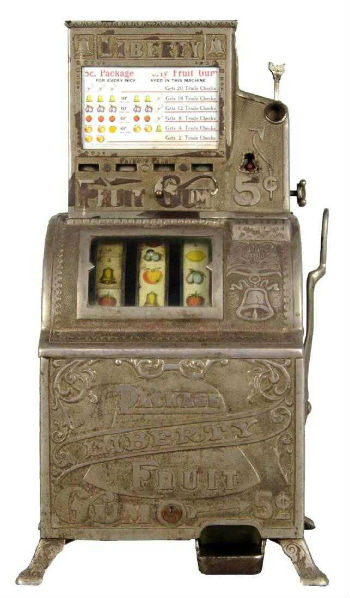
NEW YORK – The highlight of going to the supermarket with Mom as a youngster was being given a nickel or a coin to put into a candy machine and be rewarded with a brightly colored gumball of sweet goodness. In the modern era the machines are fairly utilitarian, but a century earlier these machines were artistic, often featuring smiling or frowning clowns and bold wording. They were produced in countertop and floor models.
Gum machines, often called silent salesmen as they turned a profit without requiring a salesman, were usually located in shops, banks or on elevated subway platforms. Often designed to resemble slot machines, the gum vendors at first dispensed sticks of gum, which sometimes became stuck in the mechanism.

Vendors switched around 1905-10 to a round design and many machines were then shaped with a glass globe holding gumballs atop a metal base.
A rare slot machine example was the Caille Liberty Package vendor (above) made by Caille Bros. in Detroit, Michigan, which dispensed gum and was designed possibly to circumvent strict gaming laws. “Perhaps one of the most unique early cast-iron ‘three-reel’ payout slot machines ever manufactured,” according to commentary on the website of Morphy Auctions. “In order to avoid gambling laws, the manufacturer devised a method that was somewhat ingenious, a package of gum with every play.” Morphy’s sold a circa 1905-1910 example of this vendor for $105,000 in January 2017. The machine, measuring 14½ by 13½ by 26½ inches and featuring ornate nickel-plated castings, was unusual in that the gum vendor was on top instead of at the side or base of the machine. Side-dispensing vendors were cheaper to make, so this rare example is quite coveted.
Another unusual example is a rare Blinky Eyes Jolly Fellow cast-iron one-cent gum and match dispenser made by the Standard Gum Machine Works in Pittsburgh, Pennsylvania. When gum is dispensed, the clown’s eyes blink, thus the name. The circa 1907 machine, bright orange with green accents, measuring 12¾ by 33¾ by 6¼ inches is actually two machines in one. It dispenses both gum and matches and features a game to win the customer’s coin back. Selling at Showtime Auction Services in April 2018 for $42,500, this piece is the only known extant example and came from New York’s famed Coney Island.

Clowns were popular motifs on coin-operated gum vendors, including a 1910 Columbus Model L Frowning Clown gum machine, which dispensed a piece of gum for a penny, an example of which, retaining its original paint and decal, sold for $20,000 at Showtime Auction Services in October 2015. J.W. Hance Foundry in Waterville, Ohio, manufactured the device.

A “Happy Jap” tab gum version gum machine, patented in 1902, sold for $30,000 at Showtime Auction Services in April 2014. The machine, with overt racist tones, depicted a man’s head in bright yellow paint. It came with an original porcelain enamel sign that read: “Drop one cent in and receive large piece of Happy Jap Chewing Gum/ a High Grade Gum/ Manufactured by Happy Jap Chewing Gum Co., David City, Neb.” The machine was made by the White Vending Machine Co.

Besides gum and match combinations, some machines offered baseball cards along with gum. A rare Pepsin Gum embossed tin dispenser, #3425, offered gum and a fortune for one cent. The 24 ¾-inch-tall machine features a rare tin litho decoration of a fortune teller. A fine example sold at Showtime Auction Services in October 2013 for $47,500.
One of the biggest gumball vendor manufacturers was Carousel Industries, which had its beginnings in the 1950s in Des Plaines, Ill. Several decades later, it was sold to the Ford Gum and Machine Co., another prolific maker, which manufactured gum vendors as well as gum from the early 1920s to the late 1960s.
Popular gumball vendor makers included the Advance Machine Co., which produced nearly 50 different examples of its 1-2-3 Gumball machines; the Columbus Vending Co., which made 80 different machines. The Hoff Vending Corp. produced three separate models, circa 1927, for Wrigley’s Gum. A five-cent Beech-Nut Chewing Gum machine was manufactured by the Kayem Products Co., circa 1947, and featured an illustration on the front panel of an attractive blonde wearing a white hat.
Buyers need to be aware of reproductions and replaced parts. Pieces will be expected to show wear and colors will be faded. Metal casings and the metal inside the machine should have clean edges and sharp details. Bill Enes’ book, The Silent Salesman Too is a valuable reference tool for new collectors.
Gumball vendors, especially prewar cast-iron examples, are highly collectible with their whimsical decoration, claw feet and nickel castings.
While many of these vendors were turned into scrap iron over the years, good examples remain, still bringing joy long after a penny or a nickel was traded for that first piece of gum.



